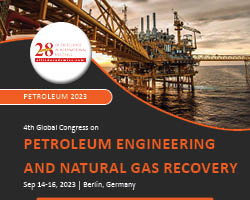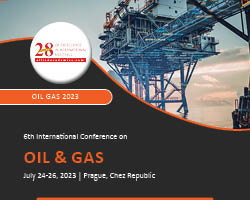2023 Conferences
Petroleum Conferences:
To create the wide blueprint for the Petroleum & Oil gas Industryand Academia professionals of AlliedAcademies Conferences put forward the immense dedication Indicating the futurism of petroleum Gathering in one land for the Industrialrevolution in Petroleum Industries. Allied Academies navigate the platform forpetroleum Industries to embrace Opportunities and Builds the pillars betweenthe industrials and Research professionals in the vision of Conference.
The Global energy demand has risen and Petroleum Persisting an indispensable part of the global energy.
“With Huge priorities for the Fuel world in daily lifePetroleum demands for the Future”
PetroleumConferences framework includes its transformative impact across the oil andgas value chain. Petroleum enrols key composing for the Critical errors in theOil & gas field, future demands on petroleum, create Business implementstotal management solutions and new Strategies across the Petroleum IndustriesLandscape. Gain access to the people that matter, which shape the energyindustry and influence the decision-making process. All Resources of petroleum plan of action for the gatherCertified with CPD Accreditation Credits with the approval Of AccreditationCommittee. Be a part of the world’s most important petroleum-oil and gasConference.
Even replacement or Innovation in the energy resourcesFossil Fuels will dominate Energy source through 2050, Oil & Gas still bethe most consuming energy sources with the consumption 55% percentage fromtotal energy production in 2019, it will increase by 16% in 2030 and continues togrow in future demands of petroleum fuels and petrochemical by-products. Bigoil is beginning to hedge its bets on the future the oil industry broadlydeploying artificial intelligence, robotics, and faster data processingthroughout their operations.
Research Development in Oil production: The booming shale drilling in the oil fields haveenormous development and ongoing research, Artificial data intelligence in theE&P faces numerous challenges Identified five grand challenges for theindustry and business is developing white papers for everyone that describe thechallenge, the present state of R&D, and areas for further researchanalysis. Oil and gas could be a high-technology industry, where scientists,companies and engineers continually challenge the barriers of what is possibleto find and produce energy. R&D has been vital in enabling the industriesto meet the new techniques and technologies discovered through global energydemand and will continue to be vital as the industry overcomes current andfuture challenges.
Renewable energy is evolution not revolution: When most Specialists thought the country’s oil reserveswere in decline, shale drilling unleashed a boom factor in natural gas and oil the production that currently appears to perpetuate the dependence on fossil fuelsexcept for coal. Overall though oil and gas, coal, will continue to be 74% of primary energy demand, down from 82% now it will acceleratein future oil production.
Oil Production Benchmark sets the Economic Growth of GDP:Over 75% of the country’s GDP wasincreasing over 58% in Oil production and its products by the Energy MarketingResources in 2019, as in future it will moderately demand to 82% of the totalGDP Expenditure on Energy and 72% in Oil production.
Earn from world-class industry experts through the 70+conference sessions, Business networking panel, Discussion panel and from over100+ speakers making this conference the largest Oil and Gas conference knowledgeplatform in the world today.
Natural gas, gasoline, naphtha, kerosene, fuel and lubricating oils, paraffin wax, and asphalt are all fractions of a thick, flammable yellow-to-black mixture of gaseous, liquid, and solid hydrocarbons that occurs naturally beneath the earth's surface. It can be separated into natural gas, gasoline, naphtha, kerosene, fuel and lubricating oils, paraffin wax, and asphalt, and is used as a raw. Petroleum is obtained from the Latin words petra and oleum, which mean "rock" and "oil," respectively. The oil business divides "crude" into categories based on its origin and relative weight or viscosity ("light", "intermediate" or "heavy"). Because of the relative sulphur content of natural oil deposits, oil is referred to either "sweet," which means it has very little sulphur, or "sour," which means it contains significant sulphur.
Many places of the world have oil and natural gas deposits. Demand was minimal in the past, and reserves were plentiful. The initial users of oil, in fact, were reliant on surface seepage for their supplies. However, as demand has grown, all of the readily available oil has been consumed. Oil exploration is now taking conducted in some of the world's most difficult locations. We're now exploring for new oil reserves hundreds of feet beneath the ocean's surface and in climate-change-prone places. (Under "Exploration and Production," you'll find more information about these technologies.
Crude oil is typically black or dark brown in colour, but it can also be yellowish, reddish, tan, or even greenish in appearance. Color differences represent the various chemical compositions of different crude oil suppliers. Petroleum with little metals or sulphur, for example, is usually lighter (sometimes nearly clear).
When petroleum products like gasoline are used for energy, poisonous chemicals and large amounts of carbon dioxide, a greenhouse gas, are released. Carbon regulates the temperature of the Earth's atmosphere, and adding to the natural equilibrium by burning fossil fuels has a negative impact on our climate.
This conference is about a hot topic right now, and it's about the worth of petroleum. This meeting covers a wide range of topics related to petroleum, from the most basic to the most advanced.
MARKET ANALYSIS:
In 2019 and early 2020, Singapore is one of the major exporters of petroleum and mining production. As one of the largest exporters of petroleum products, their total revenue in 2018 was 42 billion dollars, with a global market share of 1.7%. Singapore's annual percentage has climbed by 20%, while the global trade market has declined by 15% in early 2016. According to a 2019 poll, China and the United States are the world's major oil producing countries, producing 13.4% and 13.8 percent of global oil output, respectively. Oil production in Saudi Arabia is followed by Russia, Canada, Malaysia, and Singapore. The demand for oil in 2019 is expected to be around 99 million barrels per day. The transportation sector in the United States uses around 224 billion gallons of liquid hydrocarbon fuel each year. Around the World's Major Advanced Petroleum Industries.
CURRENT RESEARCH TRENDS:
The petroleum industry set out to conquer the deep offshore to meet expanding worldwide demand for oil and gas, and in just a few years, this severe environment has emerged as a crucial source of future supplies. The deep offshore is thought to hold more than 5% of the world's liquid hydrocarbon resources (an estimated 300 billion barrels), or 12% of total conventional oil resources, and deep water liquid reserves accounted for 6% of global output in 2013. (source TOTAL). By 2035, that percentage is expected to reach about 11% of conventional oil output, or 9 million barrels per day (source TOTAL).
SUBSEA PRODUCTION SYSTEMS TREND: The general goal of company R&D is to create and expand solutions for subsea trees, manifolds, and jumpers without increasing prices, and R&D focuses include developing so-called Inspection, Maintenance, and Repair (IMR) systems to assure long-term operations dependability and asset service life.
ULTRA-DEEPWATER INSTALLATION: In order to meet the industry's needs, these development patterns place a significant burden on the offshore installation business to continually enhance its ability to undertake such activities and create new and cost-effective installation technologies.
SUBSEA PROCESSING SYSTEMS: Subsea processing (using subsea separation and pumping technologies) was conceived as a way to overcome the challenges of extremely deep-water situations, and it has since proven to be a viable solution for fields located in harsh environments where processing equipment on the water's surface may be at risk.
NEW DEVELOPMENTS IN SUBSEA PROCESSING: There are various compact separation options that are constructed expressly according to pipe code, which is especially important in ultra-deep-water. The equipment can be coupled to fit all situations and separation requirements, whether it's for liquid/liquid, gas/liquid, or solid separation.
SAFETY AND ENVIRONMENTAL: It is a primary goal for oil and gas firms to ensure that deep-water oil and gas production does not disrupt marine ecosystems, and they do research to quantify and develop technology that can lessen the environmental hazards of ultra-deep-water oil and gas development.
SIMULATION TECHNOLOGY FOR SUBSEA PRODUCTION SYSTEMS: Simulation technology, which can examine the complicated technical and heterogeneous systems of subsea production systems, is gaining popularity. Dynamic simulation tools enable the development, virtual testing, and analysis of components and systems of any complexity, and these jobs have become much easier with the emergence of cutting-edge software programmes.
SCOPE & IMPORTANCE:
Fuel oil and liquefied petroleum gas are two types of petroleum that are sold. Automobile and truck use, as well as home heating, stimulate demand for petroleum. China and Japan are the two countries that consume the most petroleum, accounting for 20% of total global consumption. In 2013, around 5,400 enterprises in the United States sold fuel oil and LP gas, generating a total yearly income of about $770 billion. Fuel oil and LP gas sales accounted for roughly 40% of total sales, while automobile fuels accounted for around 10%. In 2021, the global oil filter market was worth US$ 3.2 billion. According to IMARC Group, the market is expected to reach US$ 4.4 billion by 2027, with a CAGR of 5.8% from 2022 to 2027. We're constantly watching and evaluating the pandemic's direct and indirect effects, keeping in mind the uncertainty of COVID-19. As a prominent market contributor, these insights are incorporated in the research.

